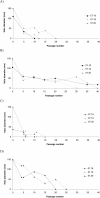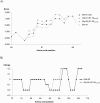Development and characterisation of highly antibiotic resistant Bartonella bacilliformis mutants
- PMID: 27667026
- PMCID: PMC5035977
- DOI: 10.1038/srep33584
Development and characterisation of highly antibiotic resistant Bartonella bacilliformis mutants
Abstract
The objective was to develop and characterise in vitro Bartonella bacilliformis antibiotic resistant mutants. Three B. bacilliformis strains were plated 35 or 40 times with azithromycin, chloramphenicol, ciprofloxacin or rifampicin discs. Resistance-stability was assessed performing 5 serial passages without antibiotic pressure. MICs were determined with/without Phe-Arg-β-Napthylamide and artesunate. Target alterations were screened in the 23S rRNA, rplD, rplV, gyrA, gyrB, parC, parE and rpoB genes. Chloramphenicol and ciprofloxacin resistance were the most difficult and easiest (>37.3 and 10.6 passages) to be selected, respectively. All mutants but one selected with chloramphenicol achieved high resistance levels. All rifampicin, one azithromycin and one ciprofloxacin mutants did not totally revert when cultured without antibiotic pressure. Azithromycin resistance was related to L4 substitutions Gln-66 → Lys or Gly-70 → Arg; L4 deletion Δ62-65 (Lys-Met-Tyr-Lys) or L22 insertion 83::Val-Ser-Glu-Ala-His-Val-Gly-Lys-Ser; in two chloramphenicol-resistant mutants the 23S rRNA mutation G2372A was detected. GyrA Ala-91 → Val and Asp-95 → Gly and GyrB Glu474 → Lys were detected in ciprofloxacin-resistant mutants. RpoB substitutions Gln-527 → Arg, His-540 → Tyr and Ser-545 → Phe plus Ser-588 → Tyr were detected in rifampicin-resistant mutants. In 5 mutants the effect of efflux pumps on resistance was observed. Antibiotic resistance was mainly related to target mutations and overexpression of efflux pumps, which might underlie microbiological failures during treatments.
Figures



References
-
- Angelakis E. & Raoult D. Pathogenicity and treatment of Bartonella infections. Int. J. Antimicrob. Agents 44, 16–25 (2014). - PubMed
-
- Ilher G. M. Bartonella bacilliformis: dangerous pathogen slowly emerging from deep background. FEMS Microbiol. Lett. 144, 1–11 (1996). - PubMed
-
- Huerta A., Salas M., Yarinsueca J. & Maguiña C. Enfermedad de Carrión grave complicada con leptospirosis aguda: reporte de un caso. Rev. Peru. Med. Exp. Salud Publ. 31, 380–384 (2014). - PubMed
-
- Maguiña C., García P. J., Gotuzzo E., Cordero L. & Spach D. H. Bartonellosis (Carrión’s Disease) in the modern era. Clin. Infect. Dis. 33, 772–779 (2001). - PubMed
LinkOut - more resources
Full Text Sources
Other Literature Sources
Miscellaneous

